Of all the ornamental plants you can grow indoors, Alocasias are among my favorite. Maybe it’s because I live in Central Oregon where winter seems to last half the year, but the striking foliage on these head-turning plants never fail to make my home feel like a tropical hideaway.
Alocasia is a genus of broad-leaved perennial flowering plants from the family Araceae (otherwise known as the aroids), containing 97 recognized species that are native to tropical and subtropical Asia and Eastern Australia. Many more varieties of Alocasia exist through hybridization.
Read more: What Are Cultivars, Varieties, Hybrids and More: Layman’s Guide to Plant Taxonomy
They range wildly in size, from species that stay compact at just 1 to 2 feet, to plants that grow over 12 feet tall with leaves spanning 3 feet in length.
For the casual plant lover, however, the majority of Alocasias sold in plant shops and garden centers are on the smaller side—a special subgroup of tropical aroids known as Jewel Alocasias—making them more manageable as houseplants.
And “jewel” is quite a fitting name, as they include the jewels of the modern houseplant boom, such as Alocasia amazonica ‘Polly,’ Alocasia baginda ‘Dragon Scale,’ and Alocasia rugosa ‘Melo.’
The Jewel Alocasias are remarkable rainforest specimens with unique leaf textures, shapes, and variegation. You may have heard of them referred to as elephant ears, a common name given to several species of similar-looking plants with large, heart-shaped leaves belonging to the genera Alocasia, Colocasia, and Xanthosoma.
Alocasias are the plants you’ll typically find growing indoors. They’re better known as upright elephant ears, since the leaves in each new clump grow vertically—that is, higher than the previous clump, while staying nearly the same width—rather than horizontally like most other tropical species.
Unless you’re lucky enough to live somewhere with an amazing specialty plant shop, the best place to buy Alocasias (especially Alocasia varieties that are less commonly available) is online, and I’ve linked to my favorite sources below.
Disclosure: If you shop from my article or make a purchase through one of my links, I may receive commissions on some of the products I recommend.
Where to buy Alocasia plants:
- FastGrowingTrees.com
- American Plant Exchange
- Brumley & Bloom
- Florida Plants Gardens
- The Green Escape
- The Longevity Garden
- The New Plant Co.
Best types of Alocasias
While they’re not the easiest indoor plants to keep alive (compared to say, Chinese evergreens, wandering Jew, or spider plants, which are among my top picks for beginners), Alocasias are very much worth the effort if you love a tropical jungle vibe in your home. (Don’t worry, I’ve got you: down below, you’ll find my best tips on caring for your Alocasia.)
But first, I’ve listed my favorite rare and more common varieties of Jewel Alocasias (with species names, common names, and pictures) to help you choose the perfect plant for your home.
1. Alocasia amazonica ‘Polly’

By far, ‘Polly’ is the most popular and readily available Alocasia variety (at least in the United States). Also known as the African Mask plant or Kris plant, it’s a hybrid of Alocasia watsoniana and Alocasia sanderiana that was bred in the 1950s by nursery owner Salvadore Mauro. The Florida grower owned a now-defunct greenhouse called Amazon Nursery and named the plant hybrid after his business. Alocasia ‘Polly’ has slender, dark green leaves with wavy, undulating edges and thick white veins running through them.
It’s a fairly compact plant, growing no more than 18 to 24 inches in height and 10 inches in width, with leaves reaching up to 16 inches long.
2. Alocasia amazonica ‘Bambino’
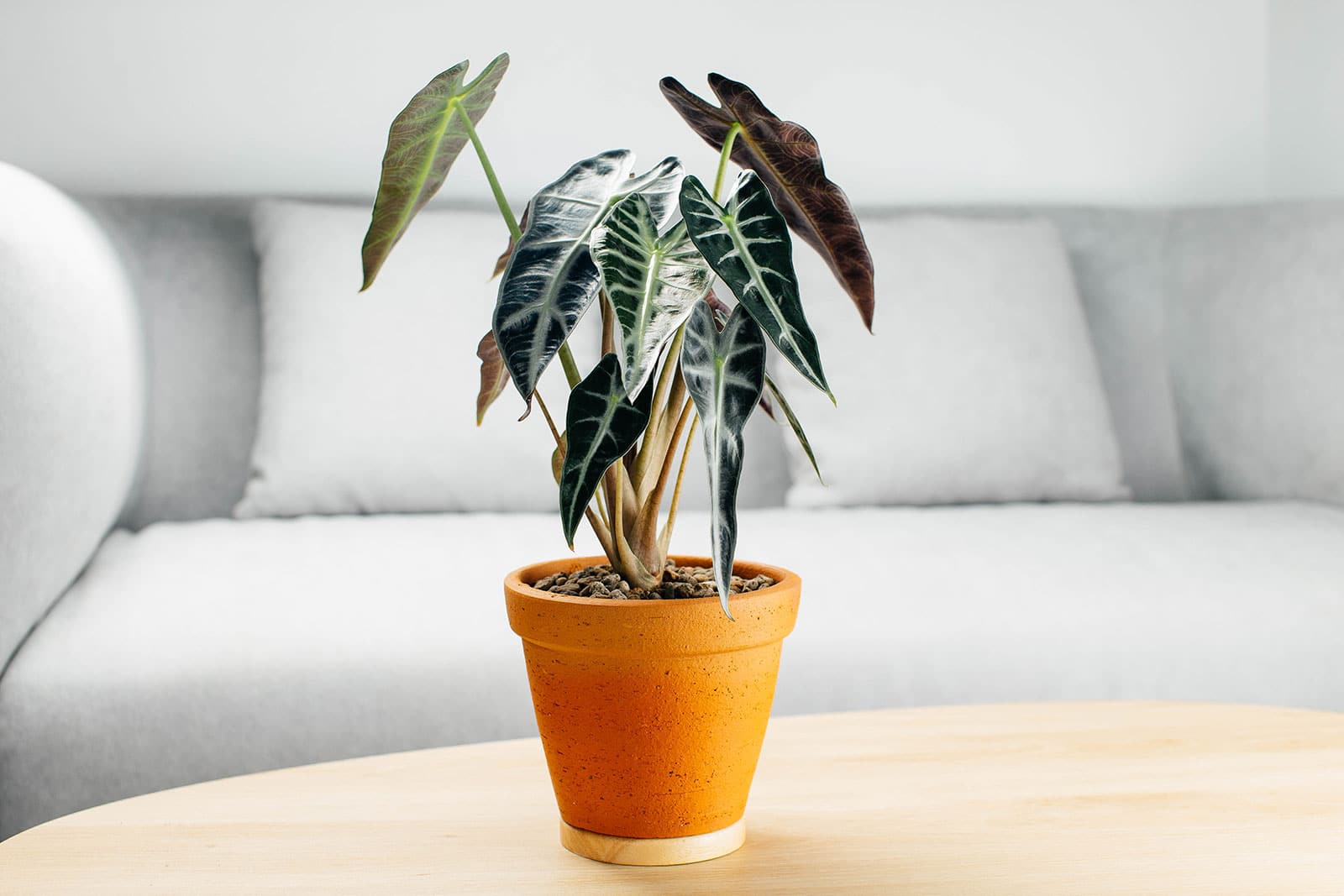
Even smaller than ‘Polly’ is ‘Bambino,’ a dwarf variety of the already compact Alocasia x amazonica. Alocasia ‘Bambino’ has deep green, arrowhead leaves with silvery green veins and purple undersides.
The plant grows up to 12 inches in height and width, with leaves that generally span 6 inches long and 2 inches broad. It’s the perfect plant for small spaces!
3. Alocasia amazonica ‘Ivory Coast’
A hybrid of Alocasia x amazonica and Alocasia ‘Aurora,’ the arrow-shaped leaves on this stunning cultivar resemble other Alocasia x amazonica species, but without the wavy, crinkled edges. It is fast-growing and well-branched with brown-streaked, blushing pink petioles.
Alocasia amazonica ‘Ivory Coast’ quickly grows to a height of 3 to 4 feet and a width of 2 to 3 feet.
4. Alocasia micholitziana ‘Frydek’

Alocasia micholitziana ‘Frydek,’ commonly called Green Velvet Alocasia, resembles Alocasia ‘Polly’ in its general size and leaf appearance, but is a little harder to find commercially. The plants have velvety (as opposed to glossy) dark green leaves with wavy edges and glowing white veins.
This medium-sized variety (as far as Alocasia plants go) grows 2 to 3 feet tall when mature and is slightly narrower than it is tall. The leaves average 18 inches long when fully grown.
5. Alocasia reginula ‘Black Velvet’
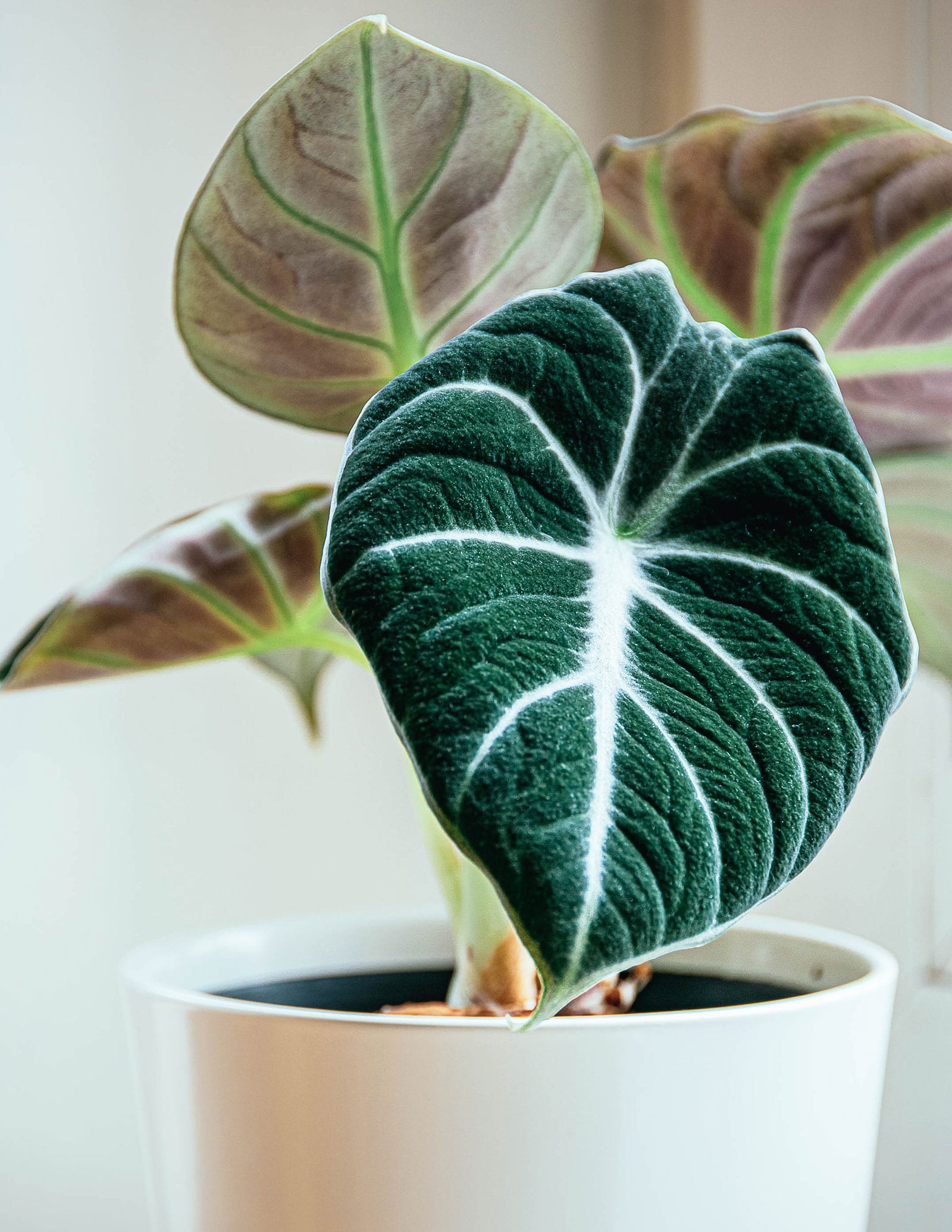
If you’re looking for a darker and more mysterious plant, Black Velvet Alocasia (also known as Little Queen) is right up your alley. The foliage develops a rich, almost-black color with silvery white veins, and has sort of a velvety texture. The heart-shaped leaves are thicker than most Alocasias and nearly succulent-like.
Black Velvet Alocasia grows to about 12 inches tall and 18 inches wide, giving it a bushier appearance than other Alocasia types.
6. Alocasia infernalis ‘Black Magic’
Even darker than ‘Black Velvet’ is Alocasia infernalis ‘Black Magic.’ Its metallic purplish-black foliage deepens as the plant matures, and in the right light, the leaves seem to shimmer with a mysterious red gleam. If you love a moody, glamorous-looking plant, this is it!
‘Black Magic’ grows to about 15 inches tall and 6 inches wide, with leaves reaching up to 6 inches long.
7. Alocasia rugosa ‘Melo’
This Jewel Alocasia has the thickest and most deeply ridged leaves, to the point where you might mistake it for an artificial plant! The rough-textured, jade green to bluish-green leaves (which look and feel almost like cardboard) have prominent, intricate veins.
With a dramatic, shrub-like shape, Alocasia ‘Melo’ grows 1 to 2 feet tall with leaves spanning up to 20 inches long and 10 inches wide.
8. Alocasia maharani ‘Grey Dragon’
If you’re thinking ‘Grey Dragon’ looks quite similar to ‘Melo,’ you’re right—it’s a hybrid of Alocasia rugosa ‘Melo’ and Alocasia reginula. This is one of the rarest varieties of Alocasias, with muted, silvery deep green foliage.
Compared to other plants in the genus, ‘Grey Dragon’ is somewhat dwarf in size. It rarely grows taller than 14 inches and its leaves span up to 6 inches long.
9. Alocasia baginda ‘Dragon Scale’
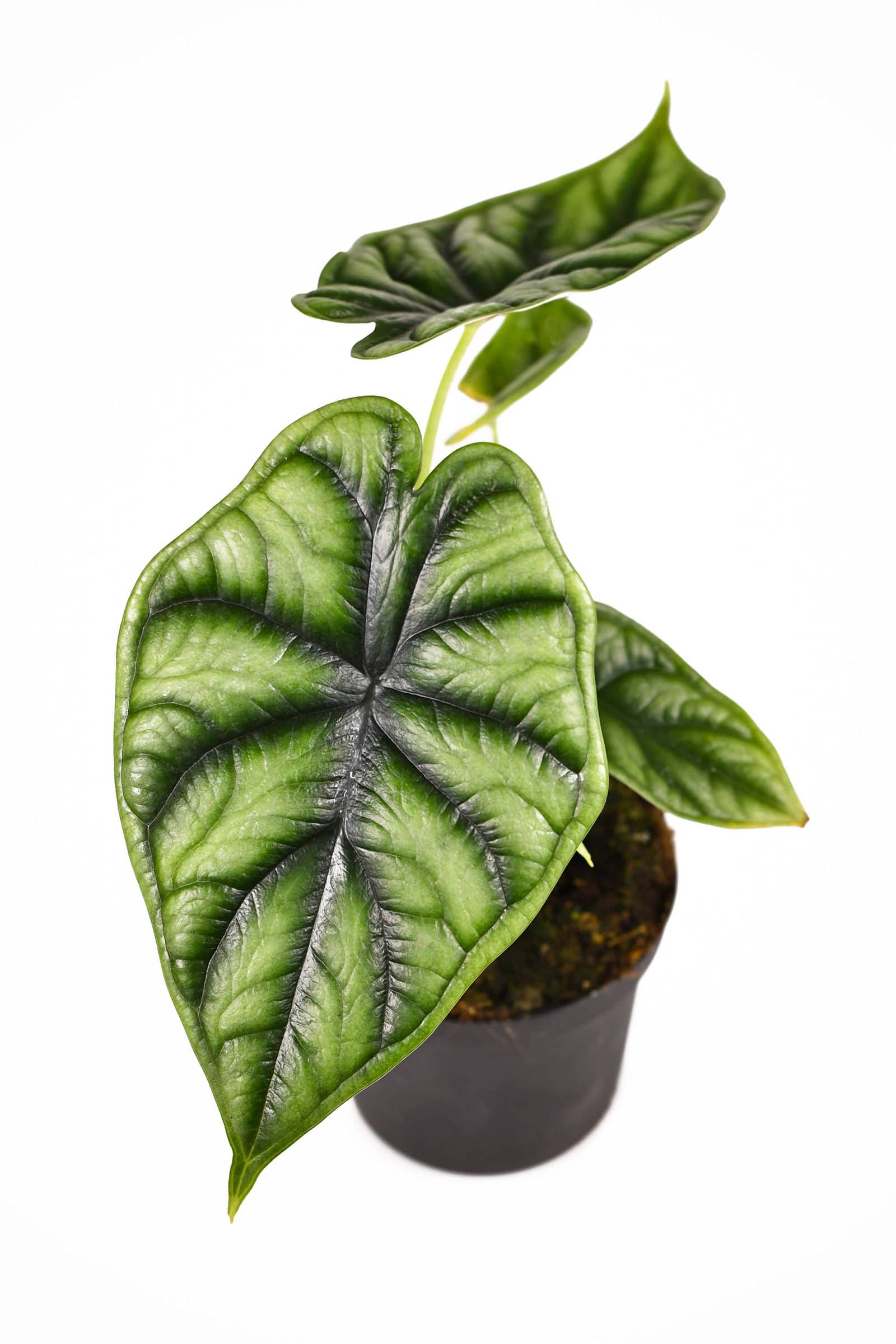
As one of the most stunning Jewel Alocasia varieties, ‘Dragon Scale’ boasts spectacular, silvery green leaves with deep green primary and secondary veins that resemble large scales (and are also slightly hardened like scales). The undersides, meanwhile, are cream with bold burgundy veins.
Alocasia baginda ‘Dragon Scale’ grows up to 3 feet in height and about half that size in width.
10. Alocasia baginda ‘Silver Dragon’
This cultivar is highly sought after for its unusual and exquisite foliage. Similar to ‘Dragon Scale,’ Alocasia baginda ‘Silver Dragon’ features pale, silvery blue leaves with primary and secondary veins that are sage green to dark green in color.
It’s a fairly compact plant that rarely reaches more than 3 feet in height and width, and even fully grown leaves stay small at about 6 inches in length.
11. Alocasia zebrina
This unique Alocasia sports the characteristic shield-shaped foliage of the rest of the genus, but without the distinctive white veins that run through the leaves. One look at Alocasia zebrina and you can guess how it got its name: its petioles are adorned with black and yellow markings reminiscent of zebra print.
Alocasia zebrina grows to a maximum height and width of about 3 feet.
12. Alocasia zebrina ‘Reticulata’
‘Reticulata’ is a cultivar of Alocasia zebrina, which means it bears the distinctive zebra print-like pattern on its petioles. What makes it different, however, is its equally distinctive leaf reticulation (an interlacing pattern resembling a net) that you won’t find on other Alocasia plants.
This unusual variety reaches up to 3 feet in height and about the same size in width.
13. Alocasia macrorrhiza ‘Stingray’ and ‘Baby Ray’
This Alocasia is unique in that it shares the same zebra-esque markings of Alocasia zebrina, but with a completely different leaf shape. The rounder, ribbed leaves point upward and outward with a long, whip-like tail at the terminal end, resembling a stingray with its “wings” and sharp tail.
Alocasia macrorrhiza ‘Stingray’ typically reaches 3 to 5 feet in height, but ‘Baby Ray’ (a dwarf strain of ‘Stingray’) maxes out at 2 to 3 feet tall.
14. Alocasia cuprea ‘Red Secret’
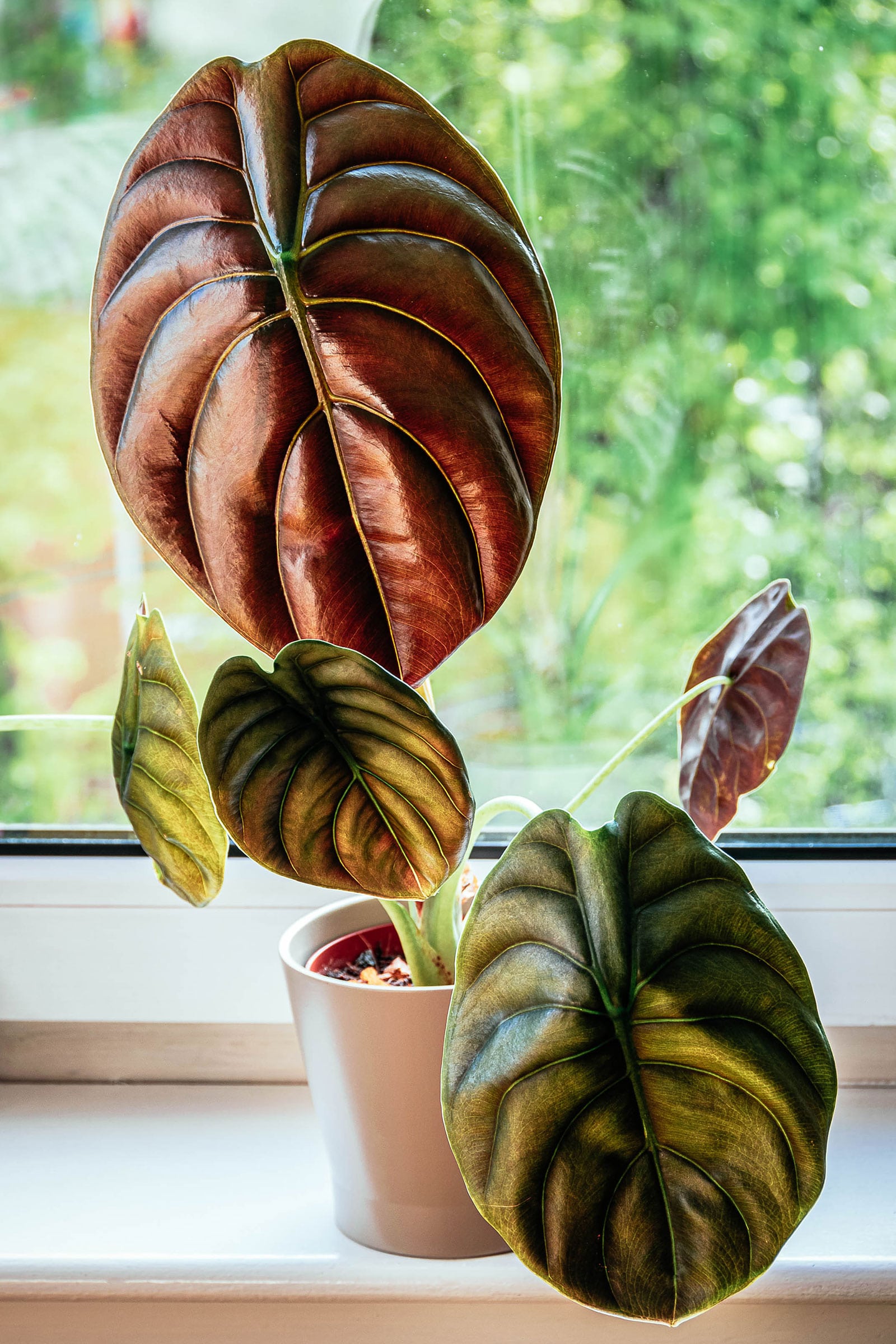
This cultivar is a standout among Alocasias with its striking reddish-pink foliage. Young leaves emerge as coppery green with a pink sheen, and over time develop into a more saturated deep green while retaining that signature pink opalescence. The veins are so dark that they almost appear black.
Alocasia cuprea ‘Red Secret’ reaches up to 3 feet in height and width, with leaves spanning 12 to 18 inches in length.
15. Alocasia cucullata ‘Hooded Dwarf’
Alocasia cucullata ‘Hooded Dwarf’ is also known as Buddha’s Hand, as it’s thought to bring good fortune and can be found in Buddhist temples across Thailand and Laos. The glossy, emerald green leaves have prominent veins on the undersides and wavy, upturned leaf margins.
As you can guess by the name, ‘Hooded Dwarf’ is smaller than some other Alocasia varieties, reaching a maximum height and width of 3 feet with leaves spanning up to 12 inches long.
16. Alocasia macrorrhizos ‘Giant Taro’
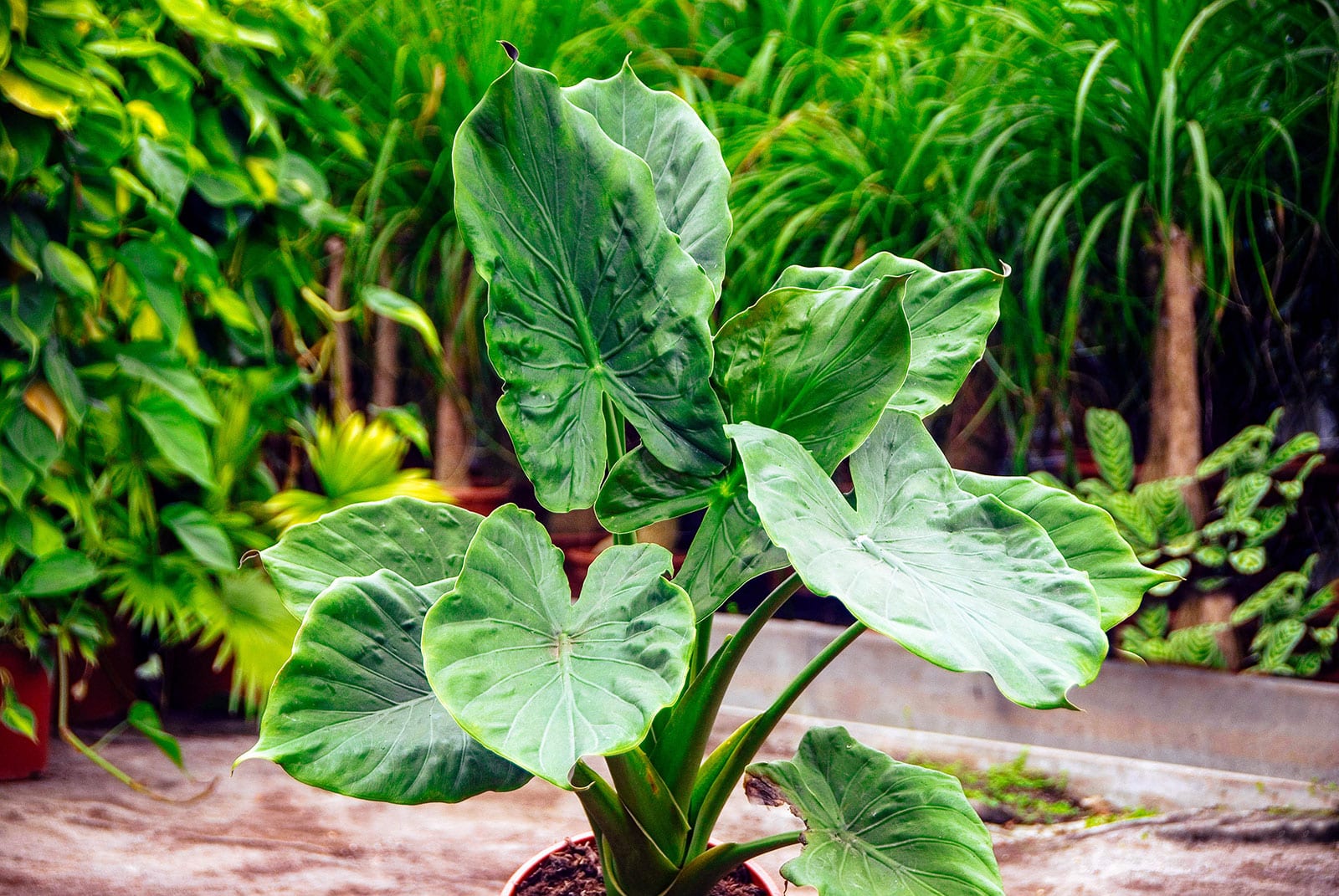
As one of the largest Jewel Alocasia varieties, Alocasia macrorrhiza is also known as ‘Giant Taro’ because of its imposing stature (though it’s not to be confused with Colocasia, the taro plant grown for its edible tubers). It has massive, arrow-shaped, shiny green leaves that tend to stay more erect on the leaf stalks than other types of Alocasias.
As a houseplant contained in a large pot, ‘Giant Taro’ grows up to 6 feet tall and 3 to 5 feet wide, with leaves spanning 3 feet long.
17. Alocasia longiloba
This cultivar is known for its narrow and dramatic shield-shaped foliage. The topside of the leaves are bluish-green with silvery white blade margins and primary veins, while the underside is a striking deep purple hue.
Alocasia longiloba stays relatively compact with a height and width maxing out at 1 to 3 feet, but with large leaves that span 2 to 3 feet long and 12 to 15 inches wide.
18. Alocasia wentii
Alocasia wentii is noted for its large, deep green foliage with surprising purple-bronze undersides. The leaves have an elongated heart shape that draws into a point to create what’s known as a “drip tip,” which allows water to neatly drop off the leaf.
This variety reaches 3 to 4 feet tall when fully grown, with huge leaves spanning up to 3 feet long to form a dramatic canopy.
19. Alocasia lauterbachiana ‘Purple Sword’
It’s easy to see where Alocasia lauterbachiana ‘Purple Sword’ gets its name from: the long, narrow leaves with their scalloped edges have a striking sword-like appearance. While the top side is glossy green, the underside is a contrasting coppery purple hue.
Mature plants grow up to 4 feet tall and 3 to 4 feet wide. The leaves, which are longer and narrower than other Alocasia varieties, reach 2 feet long but only 2 inches wide.
20. Alocasia plumbae ‘Flying Squid’
Speaking of long, narrow leaves, they don’t get any narrower than Alocasia plumbae ‘Flying Squid.’ This unusual variety reminds me of an air plant (Tillandsia) with its weird, wildly curved petioles that resemble squid arms. Look closely and you’ll see that the tubular maroon stalks end in tiny, pointed leaves.
The diminutive plant only grows to 12 inches tall and has a short lifespan, averaging 5 years.
21. Alocasia portei

Also known as the Malaysian Monster, Alocasia portei is truly a showstopper with some of the most dramatic foliage of all the Alocasias. The large-growing species features distinctive, deeply lobed leaves that remind me of arugula—a giant, tropical arugula!
When fully grown, Alocasia portei reaches 5 to 8 feet in height with enormous leaves spanning 3 to 4 feet in length.
22. Alocasia odora variegata
This variegated Alocasia has large, heart-shaped, bright green leaves mottled with white to pale green specks and patches. Every leaf shows a different pattern and ratio of color, with some leaves coming out solid green and some coming out almost solid white, making for quite a unique plant.
Alocasia odora variegata is a dwarf variety that grows 3 to 4 feet tall with leaves spanning 16 inches long.
23. Alocasia nebula ‘Imperialis’
Last but certainly not least is Alocasia nebula ‘Imperialis,’ most often touted as one of the most beautiful and rare Jewel Alocasias in the world. The very thick, leathery leaves boast a deep green to bluish-gray hue on top with a wine-red underside and dominant veins running through. The petioles are light green with merlot specks.
Alocasia nebula ‘Imperialis’ grows 2 to 3 feet tall with leaves easily reaching 17 inches in length at maturity.
How to care for Alocasia indoors
Most Alocasias have similar needs and care instructions since they’re closely related. However, it’s always a good idea to double-check how to care for your new plant when you bring it home to make sure it thrives. Here are a few tips for growing Alocasia indoors and keeping it happy.
Read more: Beginner’s Guide to Caring for Alocasia ‘Polly’ (Alocasia Amazonica or African Mask Plant)

Light
Alocasia plants prefer bright, dappled light. Since they’re naturally found in the tropics and subtropics under a canopy of trees, try to mimic this environment at home and keep them away from harsh, direct sun. In the Northern Hemisphere, an east-facing window is most ideal, or you can put them near (but not right in front of) a south-facing window.
Temperature
As heat-loving plants, Alocasias do best in a warm home that stays at least 70°F. Try not to let the temperature drop too much below 60°F, otherwise some Alocasia plants may go dormant and drop all their leaves. Avoid placing them near drafty doors or single-paned windows.
Humidity
Alocasias need plenty of humidity—at least 50 percent—to be happy. This is one reason the plants have earned their reputation as divas, as they don’t do well in dry environments. Be careful placing your Alocasia too close to a heat source (like a vent or fireplace) as this can dry out the air too much.
To increase humidity, you can keep your plant in a bathroom or kitchen (which tend to be the most humid rooms in the house), or group several plants together to create your own mini jungle paradise.
Watering
It’s no surprise that Alocasias like moisture, but how much and how often to water will depend on the amount of sunlight they get and how humid their environment is.
In summer, water your Alocasia plant once or twice a week. In winter, when growth slows down, water when the top 1 to 2 inches of soil feels dry. This may happen every 7 to 10 days, but don’t let the soil go bone dry during the cooler months.
A couple times a year, give your plant a refreshing shower in the sink or bathtub to cleanse the leaves of any dust, dirt, dander, and other particles.
Soil
Alocasias don’t like standing water, so make sure your plants are potted in loose, well-draining soil. The best “soil” for your Alocasia is actually a soilless potting mix, and you can make a good, basic potting medium by mixing sphagnum moss, bark, and perlite in equal quantities.
Ingredients for making the perfect aroid soil:
You can also buy specialty aroid soil, which is ideal for not only Alocasias, but also Monsteras, Rhaphidophoras, Philodendrons, and orchids.
Fertilizer
When it comes to fertilizer, Alocasias are thankfully pretty low-maintenance. Even during peak growing periods, they don’t demand much in terms of plant food. You can apply a monthly application of diluted liquid houseplant fertilizer in spring, summer, and fall. There’s no need to fertilize in winter when the plants aren’t actively growing.
Recommended fertilizers for Alocasia:
- Maxsea All-Purpose Seaweed Plant Food
- Houseplant Resource Center Liquid Fertilizer for Houseplants
- Instant Biologics Instant Plant Food (Fizzing Nutrient Tablets)
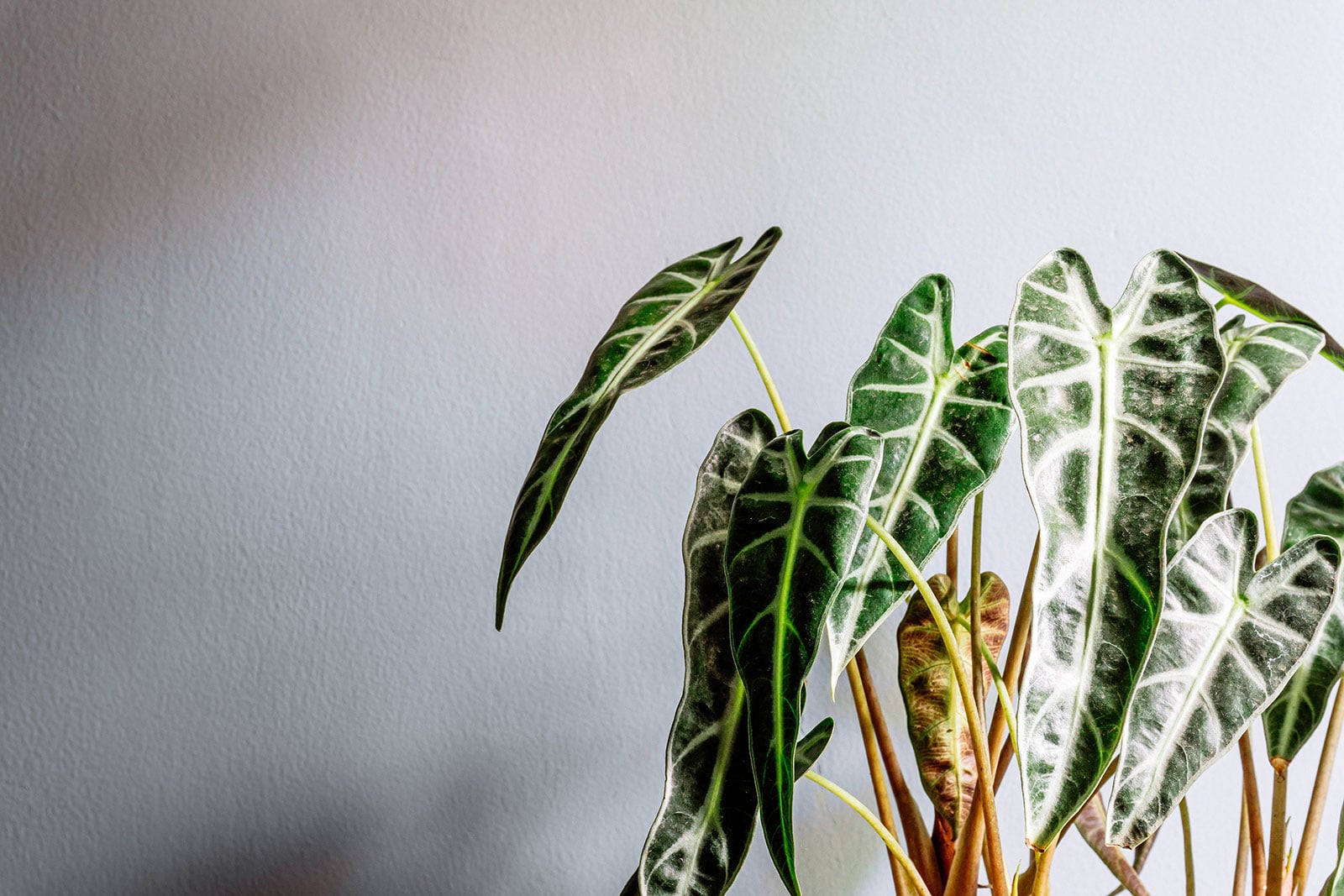
Common questions about Alocasia varieties
How many types of Alocasias are there?
There are 97 recognized types of Alocasias. While these species are native to tropical and subtropical Asia and Eastern Australia, many new Alocasia plant hybrids have been created all over the world, including the ever-popular Alocasia x amazonica and Alocasia ‘Polly’ (which are not accepted species since they are not found anywhere in native habitat—or in the Amazon, for that matter).
What is the easiest Alocasia to grow?
Alocasia amazonica ‘Polly’ is a perennial favorite for a reason. Not only is it the most readily available Alocasia in garden centers and plant shops, it’s fast growing and propagates easily by dividing the roots and replanting the sections in potting soil.
What is the rarest Alocasia?
Alocasia azlanii, also known as Red Mambo, is a relatively new and rare species of Alocasia that originated in Brunei. Difficult cultivation, short supply, and rising demand have contributed to prices that often top $200, making Alocasia azlanii one of the most expensive and hard-to-find Alocasias as well.
What is the smallest Alocasia?
Several species of Alocasia grow to a compact mature height of no more than 12 inches, including Alocasia reginula ‘Black Velvet,’ Alocasia plumbae ‘Flying Squid,’ and the hybrid strain Alocasia amazonica ‘Bambino.’
But in terms of overall size, Alocasia plumbae ‘Flying Squid’ is the smallest since its tiny leaves are nearly the same width as its pencil-thin petioles.
What is the most beautiful Alocasia?
Alocasia baginda ‘Dragon Scale’ is arguably one of the most stunning Jewel Alocasia varieties. It’s prized for the distinctive venation and coloration on its leaves, which create a texture and appearance that resemble large scales.
How can you tell the difference between Alocasia and Colocasia?
Alocasia and Colocasia both belong to the Araceae family (also known as the tropical aroid family) so they share similar characteristics. To tell each genus apart, pay attention to their leaves, which show the most obvious difference. If the leaves have tips that point down, the plant is most likely a Colocasia. If the leaves point up, the plant is probably an Alocasia.
There are exceptions, of course, particularly in hybrids like Alocasia amazonica ‘Polly,’ which is not a recognized species and has downturned leaves.
What’s the difference between Alocasia and Anthurium?
Alocasia and Anthurium are native tropical plants that both belong to the Araceae family (also known as the aroid family), which means they share similar botanical characteristics. But if you’re trying to tell these two plants apart, look at their leaves and petioles for some clues.
Alocasia leaves tend to be arrow-shaped with a more erect form, whereas Anthurium leaves tend to be heart-shaped and droopy. In Alocasias, the petioles grow directly out of the tuber, while the petioles on Anthuriums grow from the stem.
Hybridization of these aroids has led to some exceptions, of course, but this should give you a good starting point for identifying your plant.
Is Alocasia toxic to cats and dogs?
Alocasia plants do contain calcium oxalate crystals that cause a burning sensation in the mouth when the leaves are ingested. Keep these houseplants away from curious pets!
View the Web Story on Alocasia varieties.


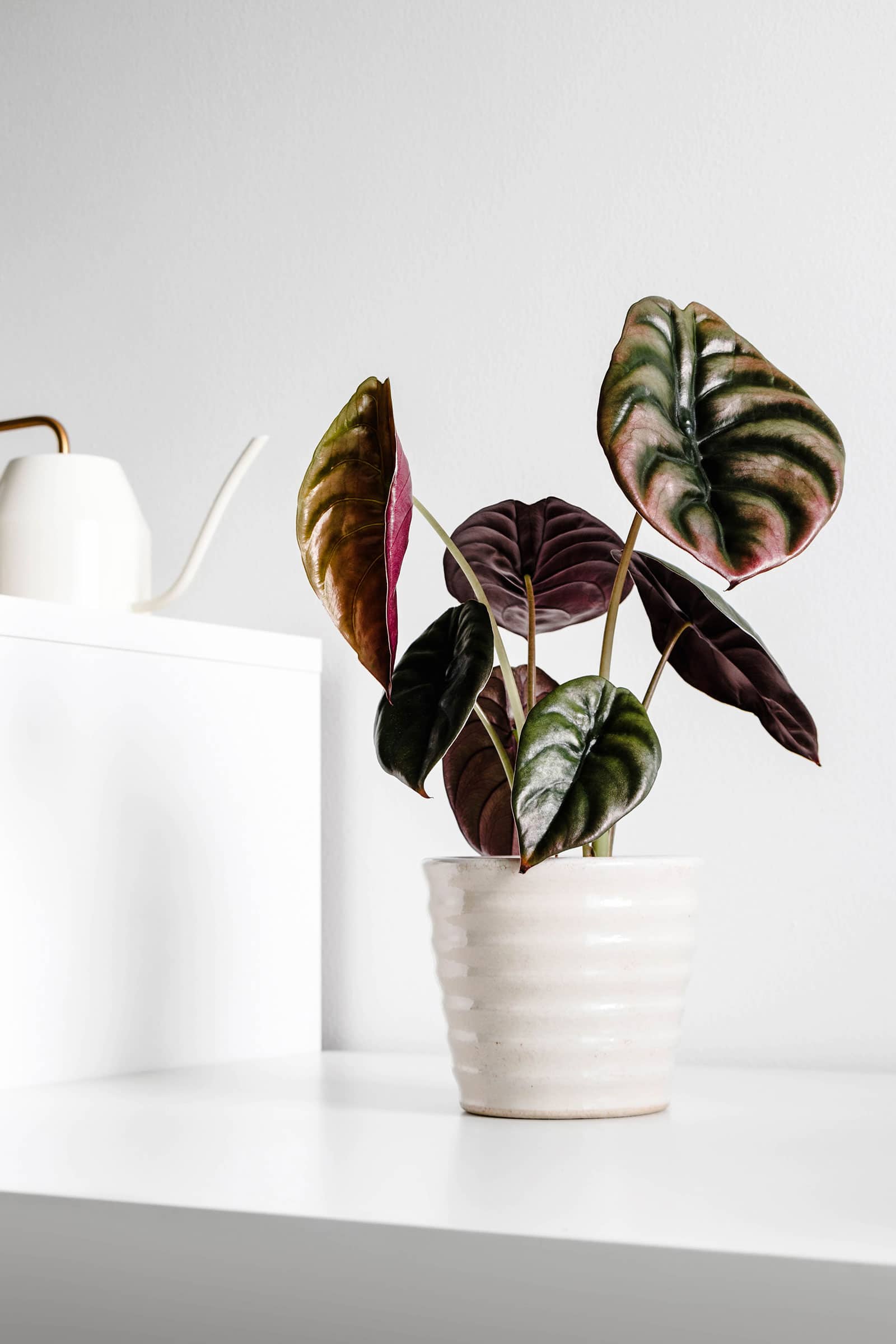













Hello Linda Ly, my name is Barbara Rowell. I’ve developed an interest in growing plants over the last 10 years or so and now I have a neighbor who gives me all the plants she’s not having much luck with, so I can try my hand with them. I’m getting some varieties that are new to me and have the PlantNet app to help me; however, I wondered if you have the time to look at a pic of some Alocasias (I think) that she gave me and confirm the speciation for me? Thanks, and will send a pic, if I hear back from you (and I’m filing this website in my “Garden” folder (loved it)!!!